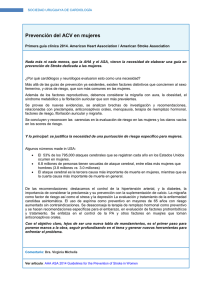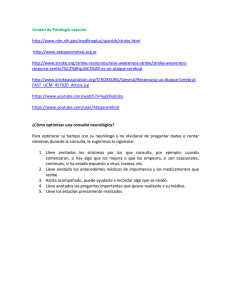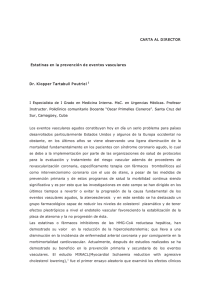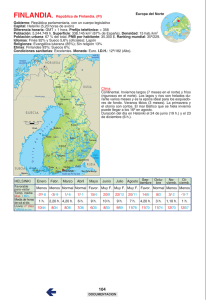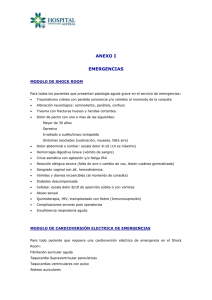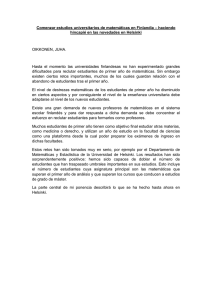TERAPIA TROMBOLITICA EN EL PACIENTE EN ESTADO CRITICO
Anuncio
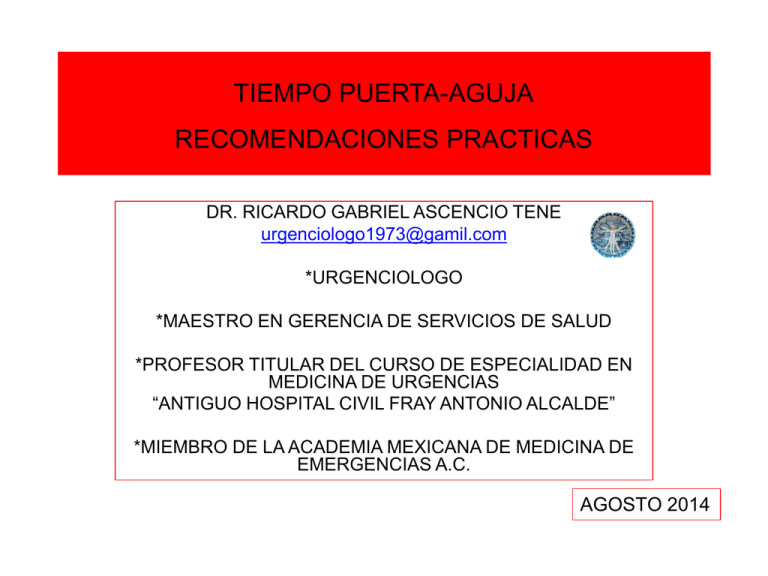
TIEMPO PUERTA-AGUJA RECOMENDACIONES PRACTICAS DR. RICARDO GABRIEL ASCENCIO TENE [email protected] *URGENCIOLOGO *MAESTRO EN GERENCIA DE SERVICIOS DE SALUD *PROFESOR TITULAR DEL CURSO DE ESPECIALIDAD EN MEDICINA DE URGENCIAS “ANTIGUO HOSPITAL CIVIL FRAY ANTONIO ALCALDE” *MIEMBRO DE LA ACADEMIA MEXICANA DE MEDICINA DE EMERGENCIAS A.C. AGOSTO 2014 PREMISA EL TRATAMIENTO OPORTUNO CON TROMBOLITICOS (rTPa) SE ASOCIA CON MEJORES RESULTADOS EN EL INFARTO CEREBRAL ISQUEMICO AGUDO (Circulation. 2007;115:e478-e534.) LOS BENEFICIOS DE LA ADMINISTRACION DE (rTPA) EN LA ENFERMEDAD CEREBRAL ISQUEMICA AGUDA SON TIEMPO-DEPENDIENTES (Stroke. 2007;38:1655-1711.) PRIMER PREMISA (TIEMPO ES CEREBRO) Odss Ratio DE TRATAMIENTO Y PRONÓSTICO Razón de momios para pronóstico favorable con rtPA IV Horas OR P 1-1.5 2.8 <0.0001 1.5-3 1.5 <0.01 3-4.5 1.4 <0.02 4.5-6 1.2 <0.26 Caplan, Rev Neurol Dis, 2004 Marler JR. Neurology 2000;55:1649 ¿POR QUÉ EL TRATAMIENTO TEMPRANO? Tiempo Neuronas Sinapsis Segundo 230 millones Fibras Envejecimiento 200 mts 8.7 hrs Minuto 1.9 14 millones millones 12 Km 31 semanas Hora 120 millones 714 Km 3.6 años 32 mil 1.2 10 horas billones 830 billones 8.3 7,140 trillones Km 36 años Saver G. Stroke 2006;37:263-266. ENERO 2005 JUNIO 2006 25 23 20 Manejo agudo y pronóstico a un año en pacientes mexicanos con un 15 primer infarto cerebral: resultados del estudio multicéntrico PREMIER 10 5 0.6 0 Arribo < 3 hs rtPA Carlos Cantú-Brito, José L. Ruiz-Sandoval, Luis M. Murillo-Bonilla, Erwin Chiquete, Carolina León-Jiménez, Antonio Arauz, Jorge Villarreal-Careaga, Ricardo Rangel-Guerra, Alma Ramos-Moreno, Fernando Barinagarrementería, y los investigadores del estudio PREMIER Rev Neurol 2010; 51 (11): 641-649 METANALISIS ACTUALIZADO QUE INCLUYE ECASS III Y EPITHET EVOLUCION FINAL Y TIEMPO DE TRATAMIENTO SAFE IMPLEMENTATION OF TROMBOLYSIS IN STROKE--MONITORING STUDY SIST-MOST TIEMPO PUERTA-AGUJA % EVOLUCION CLÍNICA Y TRATAMIENTO POR CADA 15 min AHORRADOS JAMA 2013 POR CADA 1,000 PTES TRATADOS 15 min AHORRADOS TIEMPO DE TRATAMIENTO Y MORTALIDAD Escala Modificada de Rankin NINDS 0-1 2-3 4-5 Muerte 27 27 25 20 Placebo t-PA 47 19 16 Porcentaje de Pacientes 17 TERAPIA TROMBOLÍTICA EN INFARTO CEREBRAL 1996: FDA APRUEBA EL rTPA, CON VENTANA TERAPÉUTICA DE 3 HORAS (Class I. Level of Evidence A)) 2008: ECASS III MOSTRÓ BENEFICIO 3- 4.5 HRS N Engl J Med 1995;333:1581-8. N Engl J Med 2008;359:1317-29. Procedimiento < 25 0-10 minutos Checar Evaluación Equipo de Vascular < 60 min < 45 min Tiempo Revisión de Tc y laboratorio Hora Notificar Imagen para TC simple Línea IV (candidato a trombólisis colocar 2 líneas IV) Obtener y enviar muestras de laboratorio Completar TC simple EKG completado RX completada si es necesaria Determinar uso de trombolíticos Determinar procedimientos intra-arteriales El NINDs y Stroke National Simposium Recomiendan una rápida identificación y tratamiento del Stroke agudo con el objetivo del tiempo Puerta—Aguja de 60 min. La AHA/ASA Recomiendan 1 hr desde la evaluación inicial al inicio del tratamiento con rTPA (Stroke. 2007;38:1655-1711.) Neuronas perdidas ¿ENEMIGO A VENCER EL TIEMPO? Tiempo RECENT EVIDENCE FROM THE GET WITH THE GUIDELINES– STROKE (GWTG–STROKE) NATIONAL UNITED STATES (U.S.) REGISTRY • ACTUALMENTE LA RECOMENDACIÓN DEL AHA/ASA ES LOGRAR UN TIEMPO-PUERTA AGUJA (DNT) ≤ 60 min • SIN EMBARGO GWTG-Stroke SOLO 1/4 DE LOS PACIENTES CON EVC AGUDO TRATADOS CON (tPA) DENTRO DE LAS 3 Hrs de INICIO DE LOS SINTOMAS TUVIERON UN TIEMPO PUERTA-AGUJA <60 MIN. MEDIA DE TODA LA COHORTE(595,172) (78 Min.) SAFE IMPLEMENTATION OF TROMBOLYSIS IN STROKE--MONITORING STUDY SIST-MOST • REPORTO UN TIEMPO PUERTA—AGUJA DE 68 Min. • Target: Stroke Initiative SU MAXIMO COMPONENTE SE ENFOCA EN LA REDUCCIÓN DEL TIEMPO PUERTA-AGUJA EN EL STROKE ISQUEMICO AGUDO Y EN INCREMENTAR LA PROPORCION DE PACIENTES CON STROKE QUE RECIBAN rTPA EN <60 min DESDE SU LLEGADA AL HOSPITAL (URGENCIAS) The AHA/ ASA GWTG (Stroke. 2011;42:2983-2989.) RECENT EVIDENCE FROM THE GET WITH THE GUIDELINES– STROKE (GWTG–STROKE) NATIONAL UNITED STATES (U.S.) REGISTRY ESTRATEGIAS DE MEJORES PRACTICAS 1. PRE-NOTIFICACION AL HOSPITAL DE POTENCIAL PACIENTE CON EVC 2. RAPIDO PROTOCOLO DE TRIAGE EN URGENCIAS Y NOTIFICACION AL EQUIPO DE VASCULAR 3. SISTEMA DE ACTIVACION DE LLAMADA UNICA 4. KIT DE EVC QUE CONTENGA ESCALAS, GUIAS, ALGORITMOS Y RUTAS CRITICAS ESTRATEGIAS DE MEJORES PRACTICAS 5. RAPIDA REALIZACION E INTERPRETACION DE TAC o RMN (debe realizarse en los primeros 25 min del arribo del paciente e interpretarse en los primeros 45) 6.- PRUEBAS RAPIDAS DE LABORATORIO (INR y plaquetas) 7. PREPARAR Y PRE-MEZCLAR rTPA EN CANDIDATOS, ANTES DE REALIZR ESTUDIOS DE IMAGEN 8. ACCESO RAPIDO A rTPA EN URGENCIAS O EN EL DEPRTAMENTO DE IMAGEN ESTRATEGIAS DE MEJORES PRACTICAS 9. ABORDAJE BASADO EN EL TRABAJO EN EQUIPO (aumenta las posibilidades de que aumente el numero de pacientes trombolizados) 10. LLEVAR UN REGISTRO DE DATOS CON RESPECTO A: % de pacientes trombolizados Tiempos puerta-aguja Tiempo puerta—imagen Frecuencia de complicaciones 6.20% Modelo de Regresión comparando las 2 periodos 1.36% El incremento en la tasa de pacientes con DNT <60min o menos fue de 6.20% (IC 95% 5.58%-6.78%) por periodo de 4 ¼. Post-intervención Vs 1.36% (95% IC 1.04%-1.67%) por cada 4 ¼. pre-intervención Target:Stroke (GWGL) (p=<0.001). JAMA. 2014;311(16):1632-1640. doi:10.1001/jama.2014.3203 CONCLUSIONES Y RELEVANCIA: la implementación de una iniciativa de mejoramiento nacional de calidad fue asociada con una mejora en la oportunidad de administración de rTPA seguida de un stroke. esta mejora además se asocio con una disminución de la mortalidad intra-hospitalaria y en la presentación de hemorragia intra-craneal además de aumentar el porcentaje de pacientes que son egresados a casa. JAMA. 2014;311(16):1632-1640. doi:10.1001/jama.2014.3203 ESTRATEGIAS EN EL MUNDO PARA REDUCIR TIEMPOS PUERTA—AGUJA. RE-ORGANIZACIÓN DE LA SALA DE URGENCIAS… MUEVEN EL TOMOGRAFO Y OPTIMIZAN EL TRIAGE BAJO LA PRE-NOTIFICACION DE LOS SERVICIOS MEDICOS DE AMBULANCIA (EMS) From the Departments of Neurology (P.J.L., O.H., M.K., M.K.) and Radiol- ogy (L.V.), Neuroscience Program (P.J.L.), Biomedicum Helsinki, Helsinki Emergency Medical Services (M.K.), Helsinki University Central Hospital, Helsinki, Finland. RETRASOS PRE-HOSPITALARIOS e INTRAHOSPITALARIOS EN PACIENTES QUE RECIBIERON TERAPIA TROMBOLITICA ENTRE 1999----2004 (50 pacientes consecutivos) REDUCCION DEL TIEMPO INTRAHOSPITALARIO… AUMENTO DEL ACCESO A TROMBOLISIS 23 PACIENTES EN 1999 100 en 2004 183 en 2005 RETRASOS INTRA-HOSPITALARIOS EN EL TRATAMIENTO DE STROKE ENTRE 1999-2004 (PACIENTES EN GENERAL) RETRASOS DE PACIENTES AD HOC (CANDIDATOS A TROMBOLISIS DURANTE EL MISMO PERIODO (BASADOS EN LA PRENOTIFICACION POR EMS From the Departments of Neurology (P.J.L., O.H., M.K., M.K.) and Radiol- ogy (L.V.), Neuroscience Program (P.J.L.), Biomedicum Helsinki, Helsinki Emergency Medical Services (M.K.), Helsinki University Central Hospital, Helsinki, Finland. RECOMENDACIONES DEL PROTOCOLO DE HELSINKI (AUSTRALIA) Helsinki model cut stroke thrombolysis delays to 25 minutes in Melbourne in only 4 months Atte Meretoja, Louise Weir, Melissa Ugalde, et al. Neurology 2013;81;1071-1076 Published Online before print August 14, 2013 HELSINKI DOI 10.1212/WNL.0b013e3182a4a4d2 MELBOURN This information is current as of August 14, 2013 The online version of this article, along with updated information and services, is located on the World Wide Web at: http://www.neurology.org/content/81/12/1071.full.html Neurology ® is the official journal of the American Academy of Neurology. Published continuously since 1951, it is now a weekly with 48 issues per year. Copyright © 2013 American Academy of Neurology. All rights reserved. Print ISSN: 0028-3878. Online ISSN: 1526-632X. Neurology" 2013;81:1071–1076 HELSINKI MELBOURN Neurology" 2013;81:1071–1076 1 Stroke Center and Department of Neurology, National Taiwan University Hospital, Taipei, Taiwan, 2 Division of Neurology, Department of Internal Medicine, Far-Eastern Memorial Hospital, New Taipei City, Taiwan, 3Department of Emergency Medicine, National Taiwan University Hospital, Taipei, Taiwan, 4Graduate Institute of Epidemiology and Preventive Medicine, National Taiwan University, Taipei, Taiwan CONCLUSION: CON LA IMPLEMENTACION DEL PROTOCOLO EL PORCENTAJE DE PACIENTES QUE RECIBIERON tPA INCREMENTO Y EL TIEMPO PUERTA AGUJA DISMINUYO. Capital Health, Capital Institutes for Neurosciences, Trenton and Pennington, New Jersey Neurosurgery 74:281–285, 2014 the Brain Attack Coalition suggest that “door-to-needle” time ≤ 60 min. from arrival to the emergency department (ED) to the administration of intra- venous recombinant tissuetype plasminogen activator alteplase (IV tPA) Capital Health, Capital Institutes for Neurosciences, Trenton and Pennington, New Jersey Neurosurgery 74:281–285, 2014 Reducing Door-to-Needle Times using Toyota’s Lean Manufacturing Principles and Value Stream Analysis Andria L. Ford, MD, MSCI 1, Jennifer A. Williams, RN 2, Mary Spencer, RN, MSN 3, Craig McCammon, PharmD 4, Naim Khoury, MD1, Tomoko Sampson, MD 1, Peter Panagos, MD and Jin-Moo Lee, MD, PhD1,6,*,† 1Department of Neurology, Washington University School of Medicine 2Department 3Neurology of Emergency Department, Barnes-Jewish Hospital and Neurosurgery Center, Barnes-Jewish Hospital 4Department of Pharmacy, Barnes-Jewish Hospital 5Department of Emergency Medicine, Washington University School of Medicine 6Department of Radiology, Washington University School of Medicine Abstract Background—Earlier tPA treatment for acute ischemic stroke increases efficacy, prompting national efforts to reduce door-to-needle times (DNTs). We utilized lean process improvement methodology to develop a streamlined IV tPA protocol. Methods—In early 2011, a multi-disciplinary team analyzed the steps required to treat acute 2012 December ischemic stroke patients with IV tPA, utilizing value streamStroke. analysis (VSA).; 43(12): We 3395–3398. directly compared the tPA-treated patients in the “pre-VSA” epoch to the “post-VSA” epoch with regard Reducing Door-to-Needle Times using Toyota’s Lean Table 2 Analysis Manufacturing Principles and Value Stream Protocol Metrics and Outcomes Pre- and Post-VSA. $watermark-text Andria L. Ford, MD, MSCI 1, Jennifer A. Williams, RN 2, Mary Spencer, RN, MSN 3, Crai 1, Peter Panagos, M McCammon, PharmD 4, Naim Khoury,Pre-VSA MD1, Tomoko Sampson, MDP-value Post-VSA and Jin-Moo Lee, MD, PhD1,6,*,† 1/1/2009–2/28/2011 3/1/2011–3/1/2012 N=132 N=87 1Department of Neurology, Washington University School of Medicine * 60 [46,73] Door-to-Needle Time, min 2Department of Emergency Department, % Patients with DNT ≤60min 3Neurology 39 [28,56] Barnes-Jewish Hospital 52% 78% and Neurosurgery Center, Barnes-Jewish Hospital Onset-to-Needle Time, min * <0.0001 131 [105,165] <0.0001 111 [80,158] 0.016 1 [0,4] <0.0001 4Department of Pharmacy, Barnes-Jewish Hospital 16 [10,22] 5Department of Emergency Medicine, Washington University School of Medicine 22 [16,29] 24 [17,34] 0.13 6Department of Radiology, Washington34 University School40of[31,47] Medicine 0.14 [29,42] Door-to-CT Time** , min* Door-to-CBC Time** , min* Door-to-PTT Time** , min* $watermark-text Symptomatic I CH Abstract Favorable Discharge Location + 3.0% 3.4% 1.0 76% 83% 0.24 Background—Earlier tPA treatment for acute ischemic stroke increases efficacy, prompting ++ 49% 43% 0.34 90 day mRS 0–2 national efforts to reduce door-to-needle times (DNTs). We utilized lean process improvement 3 [2,6] 0.056 * methodology to develop streamlined IV4 [3,7] tPA protocol. Length of Hospital Stay,adays 6.8% team analyzed 11.5% 0.33 to treat acute Stroke M imicearly 2011, a multi-disciplinary Methods—In the steps required ischemic stroke patients with IV tPA, utilizing value stream analysis (VSA). We directly CBC=Complete blood count patients in the “pre-VSA” epoch Stroke. 2012 “post-VSA” December ; 43(12): epoch 3395–3398. compared the tPA-treated to the with regar TRABAJO EN EQUIPO CLAVE DEL ÉXITO EN LOS SERVICIOS DE URGENCIAS Carrera contra el tiempo Ruta habitual Síntomas H o r a Traslado Evaluación Tratamiento s …………………………………………………………………………………………………………. PILAR Evaluación Tratamiento SíntomasTraslado EMERGENCIAS
